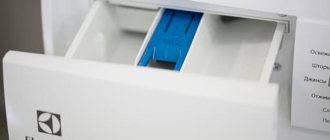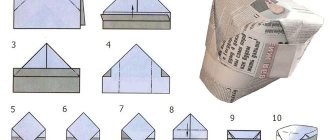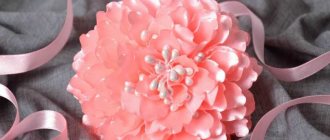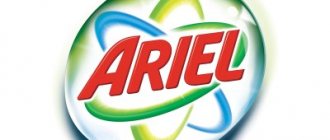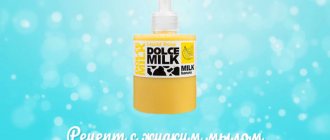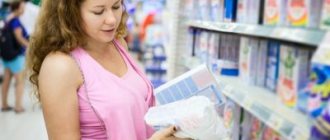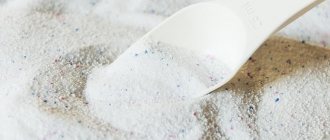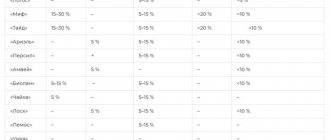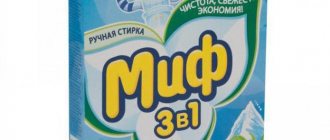Among household chemical goods that are produced industrially, there is a large assortment of washing detergents. They come in various forms.
An alternative option is to prepare the laundry detergent yourself at home.
We will tell you in this article how to make washing powder with your own hands from available ingredients.
Advantages and disadvantages of funds
Laundry detergents that you make yourself have many advantages over ready-made ones.
Their main advantages include:
- Natural composition in which you can be 100% sure.
- Safety, reducing the likelihood of allergic reactions.
- Low cost.
- Universal composition.
- Easy to use.
The negative points are the following factors:
- It takes time to prepare.
- Containers are needed for mixing the components and for storing the finished product. You will also need a spoon for stirring, a grater for grinding soap, and a measuring cup.
- All ingredients are needed in sufficient quantity.
- Not all components of natural products rinse well, especially those that contain laundry soap.
- Most homemade medications make the tissue stiff.
Homemade products are more demanding in terms of storage conditions than commercially manufactured products.
Store-bought or homemade: which is better?
Judging by the reviews of homemade powders, the opinion is mixed. Some housewives claim that there is nothing better than a product prepared at home. Others are skeptical about this idea. Natural products are valued higher, but not everyone is willing to spend personal time creating mixtures and gels when there is a ready-made chemical product in the store nearby. Everyone chooses for themselves what is best for them. Therefore, you should weigh the pros and cons of home remedies, try them and make your choice.
Composition of industrial products
The chemical content in store-bought products speaks in favor of homemade powders. What exactly are powder granules made of, and why are the chemical components dangerous? A detailed description of the composition is given in the table.
Table - Effect of components of industrial powders on the human body
| Compound | Why is it necessary? | Impact on the body |
| A-surfactants (anionic surfactants) | — Eliminate complex contaminants; - remove fat | — Remain on underwear and enter the body through the skin; - accumulate in organs; - inhibit metabolism; - weaken the immune system; - are not completely eliminated from the body |
| Sodium sulfate | — Activates the action of surfactants; – adds volume to the powder (used as a filler) | — Considered relatively safe for health; - often causes allergic reactions: dryness and irritation of the skin |
| Enzymes | Breaks down stubborn stains | — Considered relatively safe for the body; - damage fabrics (with frequent washing, clothes wear out faster); - disrupt the fiber structure |
| Phosphates | - Soften water; - weaken the electrostatic effect | — Keep surfactants on clothes; - dry the skin, disrupting barrier functions; - negatively affects metabolism; - aggravate chronic diseases |
| Phthalates | Retains fragrance | — Enter the body through the respiratory tract; - cause disturbances in the functioning of the endocrine system; - influence sexual development; - can lead to infertility |
| Optical brighteners | Reflects light, making laundry look whiter | — Penetrate through the skin; - accumulate in the body; - have a toxic toxic effect |
| Fragrances | Gives laundry a scent | — Provoke the development of respiratory tract allergies; - aggravate chronic asthma; - cause migraine |
Even knowing about the dangers of the components of the powder, many housewives continue to use it. Industrial products really do a good job of removing stains, bleaching, and giving laundry a pleasant freshness. Not all home remedies effectively and quickly deal with stains. For many consumers, the ideal outcome trumps potential health risks.
Safe home analogues
To make homemade laundry detergent with your own hands, you need to understand which substances will deal with stains and which will help whiten. The components of modern powders can be completely replaced with household products. The table shows analogues of chemical components that perform washing functions no worse than professional powders.
Table - Analogs of chemical powder components
| Functions | Household products |
| Removing stains | — Borax (sodium tetraborate); - laundry soap |
| Whitening | — Soda (baking or ash); - lemon juice; - peroxide; - laundry soap |
| Water softening | — Vinegar solution; - soda |
| Fragrance replacement | Essential oils |
It is better not to use deodorants, perfumes and granular fragrances as fragrances. The chemical composition of the products has a bad effect on human tissue and skin.
Rules of application
The use of homemade laundry detergents has its own characteristics. They are related to the consistency of the product and composition.
Machine washable
The amount of preparation for machine washing is 1 cup of dry or liquid washing powder based on a standard load (up to 5 kg of items). For slightly soiled clothing, half the dose is sufficient.
The method of application depends on the consistency of the product:
- If the powder turns out to be fine-grained, then the product can be poured into the dishwasher of the washing machine.
- If the texture of the powder is coarse, then it is advisable to first dilute the preparation with a little water, or immediately place it in the drum of the machine.
- Liquid powders can be poured both into the drum and into the powder compartment.
The use of washing soap powders, especially coarsely grated ones, can lead to incomplete dissolution. Such preparations may also be difficult to rinse out. When washing at low temperatures, homemade soap powders may be ineffective.
Manual processing
For hand washing, the amount of detergent is measured to be half that required for automatic processing.
In this case, you must proceed as follows:
- collect approximately 10 liters of water in a basin;
- dilute the powder;
- start washing.
Liquid products and fine-grained powder dissolve in water faster than products based on large chips.
DIY washing powder recipes
There are dozens of methods for making detergent composition at home. The simplest ones are passed down from generation to generation and are constantly used as an alternative to store-bought goods.
Some instructions include aromatic esters, while others focus on whitening and brightening results. What all methods have in common is low price, safety, and efficiency.
Eco-friendly cleaning recipes:
| Name | Description |
| Classical |
|
| A simplified version of the classic recipe |
|
| For baby clothes |
|
| For colored clothes |
|
| For white fabrics |
The ingredients have the same proportion |
| For stubborn stains |
|
The procedure for making the mixture will always be the same:
- Take a suitable container. The soap is grated on a fine grater.
- The necessary ingredients are added one by one to the bowl. Soda is first added to the bowl with soap crumbs, then borax and salt. Oily esters are added at the very end.
- The entire list of elements is well mixed. The finished mass is placed in an airtight form.
Intensive washing gel
The list of ingredients required to prepare the liquid cleaner includes:
- water – 1.5 liters;
- soap - half a piece;
- soda ash - 200 g;
- borax – 100 g;
- essential oil – 12-14 drops.
Instructions for preparing the gel:
- The soap is rubbed into very fine shavings and placed in a pan of hot water.
- The container is heated over medium heat. The composition simmers until it becomes homogeneous.
- Soda and borax (pre-soaked) are added to the mixture. The resulting consistency mixes well. If necessary, add liquid.
- After complete cooling, aromatic oils are added to the mass.
- The finished product is poured into a mold, covered with a lid and left in a cool place for 8-10 hours.
DIY gel for children's clothing
The composition intended for washing a child’s clothes has a more gentle structure.
Instead of 72% laundry soap, hypoallergenic baby soap is used. Borax is excluded from the consistency. Soda ash can be replaced with baking soda.
The step-by-step production is the same as in the previous recipe for regular gel. To prevent colds and fungal infections in babies, tea tree, eucalyptus or mint oils are added to the washing structure.
Paste for whitening clothes
To make a more concentrated paste-like mass, simple ingredients are needed: distilled or running water, soap, borax, soda.
To obtain the paste, you need 1.5 liters of liquid, a bar of soap (any), one glass each of soda and borax.
The procedure for making the mixture is as follows:
- The soap is rubbed and placed in a cooking container, filled with cold water.
- The pan is placed on the fire and heated until the soap shavings are completely dissolved.
- The composition contains soda and borax. All ingredients are mixed and simmered until the resulting consistency increases several times.
- The mass is covered and left to cool.
If the mixture is too thick, you can add a little boiling water, stir and refrigerate for 24 hours.
Soft conditioner for clothes
The tasks of any air conditioner include:
- make clothes softer and more pleasant;
- rid the fabric of the “electrification” effect;
- facilitate easy ironing.
Regular vinegar essence can easily cope with these functions. Making a homemade softener is quite simple. Dissolve 1.5 tablespoons of 9% vinegar in 500 ml of warm water, then gradually add the same amount of baking soda.
How to store?
A prerequisite for storing detergents is tightly closed packaging and protection from children and animals. Liquid products are best stored in the refrigerator, dry products can be kept at room temperature.
Since the composition does not contain anti-caking ingredients or to maintain the consistency of the product, it is advisable not to make large reserves - otherwise the powder may disappear .
The shelf life of a dry product that is pre-dried and stored under a lid and in a dark place is up to three years.
For liquid mixtures, the shelf life is much shorter - up to a month, when stored in a cool, dark place. Violating the rules for storing a home remedy can lead to its damage.
How to replace surfactants?
The main function of the detergent composition is cleansing from contaminants , but harmlessness is also important.
Eco-friendly substances suitable for washing are available in almost every home. The main element of a homemade solution is soap.
The important ingredients are baking soda and acetic acid. Other inexpensive substances can be purchased in the hardware section of the supermarket or pharmacy. These include borax and soda ash.
Natural structures do not have allergens or synthetic impurities. The self-prepared concentrate does not remain on fabric particles, but is easily washed off when rinsing.
To make your own cleaning mixes you will need bowls, a grater and large glass containers.
Effective substitutes for chemical components
In most cases, you can find a harmless replacement for aggressive chemicals in your own kitchen. For example, surfactants and enzymes can replace regular soap. The optimal option is economic 72%. Instead, you can use tar soap or coconut soap. Baby soap gives excellent results in terms of cleanliness and safety.
Borax or boric acid is used for the same purpose. It will quickly and carefully remove even the most difficult stains without reducing the strength of the fabric fibers. Baking soda is perfect for fighting stains; it can be replaced or enhanced with soda ash (baking soda).
Citric acid will help restore the whiteness of things. Hydrogen peroxide is also used as a bleaching component. Vinegar can be added to reduce water hardness, and it will also preserve the bright colors of the fabric. A drop of aromatic oil can easily replace a chemical fragrance.
Possible reasons for home experiments
The appearance of an infant in the home
The first and main reason to start creating your own powder.
The delicate skin of a baby may not react in the best way to the use of purchased chemicals (even special, hypoallergenic ones). In such cases, mothers only have baby soap, but hand washing in large volumes is an energy-consuming process.
The simplest washing powder can be made from the same soap using a kitchen grater. Several bars without additives are ground into powder, poured into a dry, clean, tightly closed jar - and used as needed (2-3 tablespoons per wash).
The appearance of skin irritation
The second significant reason is an allergic reaction, asthmatic manifestations in the housewife herself when using purchased products.
Cheapness
An important point is the difference in the cost of proprietary chemicals and homemade powders. The latter turn out to be much cheaper, demonstrating the same (or even higher) efficiency.
What you need for cooking
Most recipes use soap as the main ingredient. So stock up on them for future use. And also prepare the containers and devices that you will need for work:
- a saucepan that would not be a pity;
- wooden spoon;
- containers (bottles).
For all classic homemade powders you need to take:
- soap (make sure there are no fragrances in the composition);
- soda ash or baking soda;
- citric acid;
- lavender essential oil (or another of your choice, such as tangerine or eucalyptus);
- borax;
- table rock salt;
- water.
Beneficial properties of the listed ingredients:
- Borax (Na teraborate) is a mineral that has cleaning properties due to its alkaline composition. Included in fabric softeners. Fights fungi and bacteria.
- Baking soda perfectly neutralizes pH if there is an excess of alkali or acid. Baking soda also makes the fabric softer and has a disinfecting effect on it.
- Soap is a common hand wash product, but if used correctly in recipes, it can also be used in SMA.
- Oils give the product a pleasant smell.
- Salt and citric acid additionally remove stains from the fabric.
- Water is needed to give consistency.
Important! If this is your debut in making homemade powder, take a few recipes and make “samples” to choose the appropriate option.
